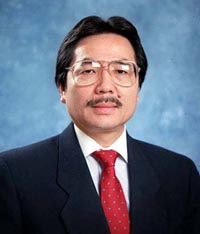Home > Introduction > Articles > Patrick Bailey > Piercing the Nano-world of Living Cells
Patrick Bailey - Piercing the Nano-world of Living Cells
Last Updated: Monday, 20-Apr-2015 19:51:36 PDT

Patrick Bailey
January 09, 2006
Piercing the Nano-world of Living Cells
An ongoing research project led by Dr. Tuan Vo-Dinh, at the Advanced Biomedical Science and Technology Group, Oak Ridge National Laboratory, has produced a "nanoneedle" capable of probing individual living cells.
More accurately described as a nanobiosensor, Vo-Dinh's device is one among a growing class of tools designed for numerous medical applications at the cellular level. This device uses a needle-like probing tip that is a mere 40 nanometers (nm). To put this remarkably small size into perspective, the width of a human hair is approximately 100,000 nanometers.

Dr. Tuan Vo-Dinh. Copyright © Oak Ridge National Laboratory |
The Oak Ridge team's probe is a single-use device. Its design includes a bare 40nm fiber-optic tip and a 350nm silver-coated arm. The arm's silver coating channels a laser light to the needle-like tip. The purpose of the coating is to improve the probe's accuracy by ensuring that light doesn't leak into the surrounding environment outside a cell.
Before Vo-Dinh's probe is used to investigate a cell, his team attaches antibodies to the end of the tip. Once inside a cell, these antibodies bond with the specific chemicals inside the cell that researchers want to investigate. The combination of the antibodies and the laser light at the probe's tip create reactions with these internal chemicals, which causes them to glow.
Improving the amount of site-specific control over what researchers are able to investigate inside cells is referred to as improving probing specificity. Improved probing specificity is one of the most important aspects of Vo-Dinh's research efforts. In a 2002 publication, Vo-Dinh said, "Many traditional microscopy techniques involve incubation of cells with fluorescent dyes or with nanoparticles containing dye molecules and examining the interaction of these dyes with compounds of interest. However, when a dye is incubated into a cell, it is transported to certain intracellular sites that may or may not be where it is most likely to stay and not to areas where the investigator would like to monitor."
Another achievement of Vo-Dinh's research relates to maintaining cell vitality. "We're able to probe individual cells without causing significant damage to them," he said. Unlike previous techniques, the Oak Ridge team's design significantly reduces the risk of cell trauma, which often resulted in the death of a cell once it was probed.
Vo-Dinh's team aimed to understand how protein and DNA expression affect the health of individual cells. To do this, they incubated living rat liver cells with Benzo alpha Pyrene (BaP) - a known cancer-causing substance. This substance was used because it's not only known to cause cancer, but is also a known mutagen - a chemical capable of altering gene expression in DNA - and is commonly found in polluted urban environments.
A similar project at the National Institute of Advanced Industrial Science and Technology (AIST) in Japan produced a nanoneedle intended to control differentiation in embryonic stem cells - allowing researchers to turn embryonic stem cells into specific organ cells, such as heart, liver, and kidney cells.
Recently, the Oak Ridge National Laboratory team applied for a patent on the technology for their nanobiosensor. Their future objectives include developing arrays of these probing sensors that could simultaneously examine groups of cells in human bodies.
Improvements in such nanoscale probing techniques are expected to revolutionize disease treatment and detection by allowing diseases to be confronted at the molecular level. In fact, it's so important that the National Cancer Institute (NCI) has implemented funding for a $144.3 million, five-year initiative for nanotechnology in cancer research. In an October, 2005, press release, NCI's director Andrew von Eschenbach, M.D., said that such devices "will enable researchers to probe genetic defects inside cells, detect the earliest aberrations of cellular function that lead to cancer, and correct those errant processes long before they give rise to cancers large enough to be diagnosed by today's methods."
Related links:
Profile
Bio
|
Patrick Bailey holds a masters degree in philosophy from the University of South Florida. He specializes in the philosophy of mind, neuroscience, and theory of knowledge, and is a technical writer for the IT industry.
|
|
|
||
|
|
||
| The latest news from around the world, FREE | ||
|
|
||
|
|
||
| Premium Products | ||
|
|
||
|
Only the news you want to read!
Learn More |
||
|
|
||
|
Full-service, expert consulting
Learn More |
||
|
|
||